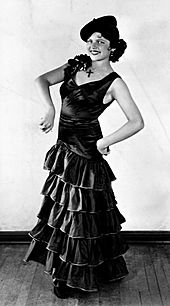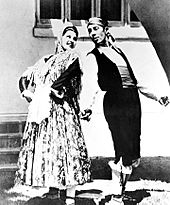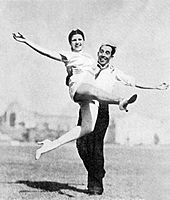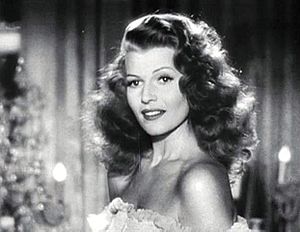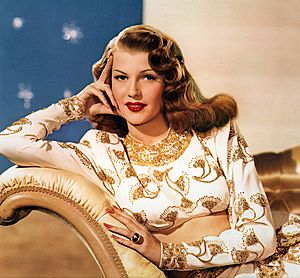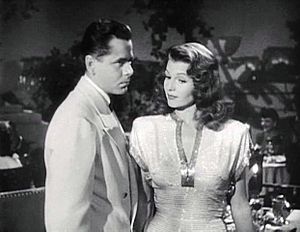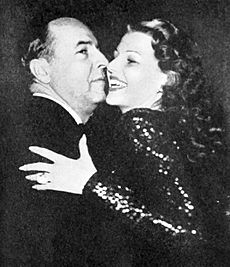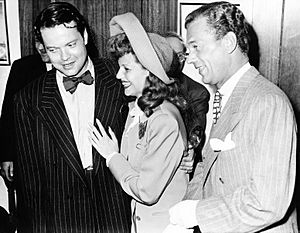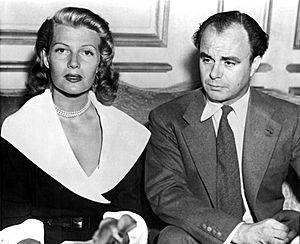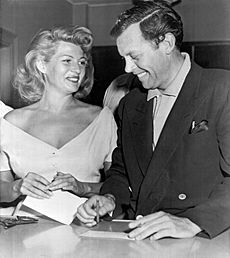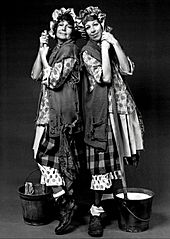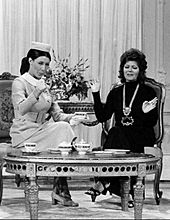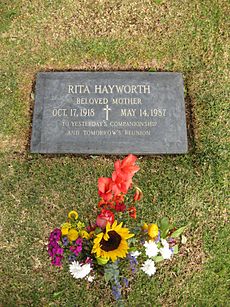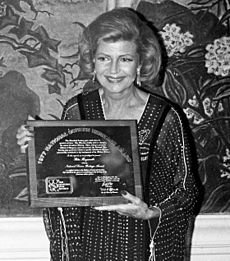Rita Hayworth facts for kids
Quick facts for kids
Rita Hayworth
|
|
|---|---|
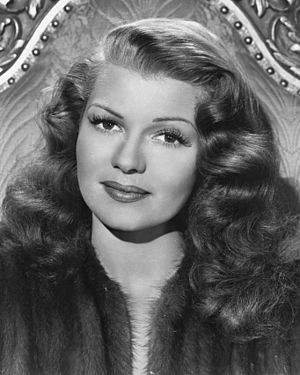
Hayworth in 1947
|
|
| Born |
Margarita Carmen Cansino
October 17, 1918 New York City, U.S.
|
| Died | May 14, 1987 (aged 68) New York City, U.S.
|
| Cause of death | Alzheimer's disease |
| Resting place | Holy Cross Cemetery, Culver City |
| Occupation |
|
| Years active | 1931–1972 |
| Political party | Democratic |
| Spouse(s) |
Edward C. Judson
(m. 1937; div. 1942)Dick Haymes
(m. 1953; div. 1955)James Hill
(m. 1958; div. 1961) |
| Children | 2, including Yasmin Aga Khan |
| Parents |
|
| Relatives |
|
| Signature | |
Rita Hayworth (born Margarita Carmen Cansino; October 17, 1918 – May 14, 1987) was an American actress, dancer and producer. She achieved fame during the 1940s as one of the era's top stars, appearing in 61 films over 37 years. The press coined the term "The Love Goddess" to describe Hayworth after she had become the most glamorous screen idol of the 1940s. She was the top pin-up girl for GIs during World War II.
Hayworth is perhaps best known for her performance in the 1946 film noir Gilda, opposite Glenn Ford, in which she played the femme fatale in her first major dramatic role. She is also known for her performances in Only Angels Have Wings (1939), The Strawberry Blonde (1941), Blood and Sand (1941), The Lady from Shanghai (1947), Pal Joey (1957), and Separate Tables (1958). Fred Astaire, with whom she made two films, You'll Never Get Rich (1941) and You Were Never Lovelier (1942), once called her his favorite dance partner. She also starred in the Technicolor musical Cover Girl (1944), with Gene Kelly. She is listed as one of the top 25 female motion picture stars of all time in the American Film Institute's survey, AFI's 100 Years...100 Stars.
In 1980, Hayworth was diagnosed with early-onset Alzheimer's disease, which contributed to her death in 1987 at age 68. The public disclosure and discussion of her illness drew attention to Alzheimer's, and helped to increase public and private funding for research into the disease.
Early life
Hayworth was born as Margarita Carmen Cansino in Brooklyn, New York, the oldest child of two dancers. Her father, Eduardo Cansino, was of Romani descent from Castilleja de la Cuesta, a little town near Seville, Spain.
Her mother, Volga Hayworth, was an American of Irish and English descent who had performed with the Ziegfeld Follies. The couple married in 1917. They also had two sons: Eduardo Jr. and Vernon. Her maternal uncle Vinton Hayworth was also an actor.
Margarita's father wanted her to become a professional dancer, while her mother hoped she would become an actress. Her paternal grandfather, Antonio Cansino, was renowned as a classical Spanish dancer. He popularized the bolero, and his dancing school in Madrid was world-famous. Antonio Cansino instructed Rita Hayworth's first dance lesson. Hayworth later recalled, "From the time I was three and a half ... as soon as I could stand on my own feet, I was given dance lessons." She noted "I didn't like it very much ... but I didn't have the courage to tell my father, so I began taking the lessons. Rehearse, rehearse, rehearse, that was my girlhood."
She attended dance classes every day for a few years in a Carnegie Hall complex, where she was taught by her uncle Angel Cansino. Before her fifth birthday she was one of the Four Cansinos featured in the Broadway production of The Greenwich Village Follies at the Winter Garden Theatre. In 1926, at the age of eight, she was featured in La Fiesta, a short film for Warner Bros.
In 1927, her father took the family to Hollywood. He believed that dancing could be featured in the movies and that his family could be part of it. He established his own dance studio, where he taught such stars as James Cagney and Jean Harlow.
In 1931, Eduardo Cansino partnered with his 12-year-old daughter to form an act called the Dancing Cansinos. Her hair was dyed from brown to black to give her a more mature and "Latin" appearance. Since under California law Margarita was too young to work in nightclubs and bars, her father took her with him to work across the border in Tijuana, Mexico. In the early 1930s, it was a popular tourist spot for people from Los Angeles. Because she was working, Cansino never graduated from high school, but she completed the ninth grade at Hamilton High in Los Angeles.
Cansino (Hayworth) took a bit part in the film Cruz Diablo (1934) at age 16, which led to another bit part in the film In Caliente (1935) with the Mexican actress Dolores del Río. She danced with her father in such nightspots as the Foreign and the Caliente clubs. Winfield Sheehan, the head of the Fox Film Corporation, saw her dancing at the Caliente Club and quickly arranged for Hayworth to do a screen test a week later. Impressed by her screen persona, Sheehan signed her for a short-term, six-month contract at Fox, under the name Rita Cansino, the first of two name changes during her film career.
Career
Early career
During her time at Fox, Hayworth was billed as Rita Cansino and appeared in unremarkable roles, often cast as the exotic foreigner. In late 1934, aged 16, she performed a dance sequence in the Spencer Tracy film Dante's Inferno (1935), and was put under contract in February 1935. She had her first speaking role as an Argentinian girl in Under the Pampas Moon (1935). She played an Egyptian girl in Charlie Chan in Egypt (1935), and a Russian dancer in Paddy O'Day (1935). Sheehan was grooming her for the lead in the 1936 Technicolor film Ramona, hoping to establish her as Fox Film's new Dolores del Río.
By the end of her six-month contract, Fox had merged into 20th Century Fox, with Darryl F. Zanuck serving as the executive producer. Dismissing Sheehan's interest in her and giving Loretta Young the lead in Ramona, Zanuck did not renew Cansino's contract. Sensing her screen potential, salesman and promoter Edward C. Judson, with whom she would elope in 1937, got freelance work for her in several small-studio films and a part in the Columbia Pictures feature Meet Nero Wolfe (1936). Studio head Harry Cohn signed her to a seven-year contract and tried her out in small roles.
Cohn argued that her image was too Mediterranean, which limited her to being cast in "exotic" roles that were fewer in number. He was heard to say her last name sounded too Spanish. Judson acted on Cohn's advice: Rita Cansino became Rita Hayworth when she adopted her mother's maiden name, to the consternation of her father. With a name that emphasized Irish-American ancestry, people were more likely to regard her as a classic "American".
With Cohn and Judson's encouragement, Hayworth changed her hair color to dark red and had electrolysis to raise her hairline and broaden the appearance of her forehead.
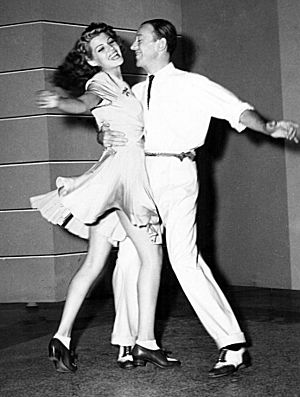
Hayworth appeared in five minor Columbia pictures and three minor independent movies in 1937. The following year, she appeared in five Columbia B movies. In 1939, Cohn pressured director Howard Hawks to use Hayworth for a small, but important, role as a man-trap in the aviation drama Only Angels Have Wings, in which she played opposite Cary Grant and Jean Arthur.
Cohn began to build up Hayworth in 1940 in features such as Music in My Heart, The Lady in Question, and Angels Over Broadway. That year, she was first featured in a Life magazine cover story. While on loan to Warner Bros., Hayworth appeared as the second female lead in The Strawberry Blonde (1941), opposite James Cagney.
She returned in triumph to Columbia Pictures, and was cast in the musical You'll Never Get Rich (1941) opposite Fred Astaire in one of the highest-budgeted films Columbia had ever made. The picture was so successful, the studio produced and released another Astaire-Hayworth picture the following year, You Were Never Lovelier. Astaire's biographer Peter Levinson writes that the dancing combination of Astaire and Hayworth was "absolute magnetism on the screen". Although Astaire made 10 films with Ginger Rogers, his other main dancing partner, Hayworth's sensuality surpassed Rogers's cool technical expertise. "Rita's youthful exuberance meshed perfectly with Fred's maturity and elegance", says Levinson.
When Astaire was asked who his favorite dance partner was, he tried not answering the question, but later admitted it was Hayworth: "All right, I'll give you a name", he said. "But if you ever let it out, I'll swear I lied. It was Rita Hayworth." Astaire commented that "Rita danced with trained perfection and individuality ... She was better when she was 'on' than at rehearsal."
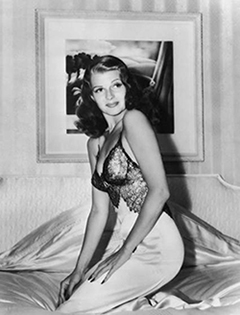
In August 1941, Hayworth was featured in an iconic Life photo in which she posed in a negligee with a black lace bodice. Bob Landry's photo made Hayworth one of the top two pin-up girls of the World War II years; the other was Betty Grable, in a 1943 photograph. For two years, Hayworth's photograph was the most requested pin-up photograph in circulation. In 2002, the satin nightgown Hayworth wore for the photo sold for $26,888.
In March 1942, Hayworth visited Brazil as a cultural ambassador for the Roosevelt administration's Good Neighbor policy, under the auspices of the Office of the Coordinator of Inter-American Affairs. During the 1940s Hayworth also contributed to the OCIAA's cultural diplomacy initiatives in support of Pan-Americanism through her broadcasts to South America on the CBS "Cadena de las Américas" radio network.
Peak years at Columbia
Hayworth had top billing in one of her best-known films, the Technicolor musical Cover Girl, released in 1944. The film established her as Columbia's top star of the 1940s, and it gave her the distinction of being the first of only six women to dance on screen with both Gene Kelly and Fred Astaire. "I guess the only jewels of my life", Hayworth said in 1970, "were the pictures I made with Fred Astaire ... And Cover Girl, too."
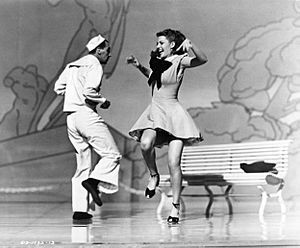
For three consecutive years, starting in 1944, Hayworth was named one of the top movie box-office attractions in the world. She was adept in ballet, tap, ballroom, and Spanish routines. Cohn continued to showcase Hayworth's dance talents. Columbia featured her in the Technicolor films Tonight and Every Night (1945) with Lee Bowman and Down to Earth (1947) with Larry Parks.
Her glamorous appeal was most noted in Charles Vidor's film noir Gilda (1946) with Glenn Ford, which caused censors some consternation. The role made Hayworth into a cultural icon as a femme fatale.
While Gilda was in release, it was widely reported that an atomic bomb which was scheduled to be tested at Bikini Atoll in the Pacific Ocean's Marshall Islands would bear an image of Hayworth, a reference to her devastating beauty. Although the gesture was undoubtedly meant as a compliment, Hayworth was deeply offended. Orson Welles, then married to Hayworth, recalled her anger in an interview with biographer Barbara Leaming: "Rita used to fly into terrible rages all the time, but the angriest was when she found out that they'd put her on the atom bomb. Rita almost went insane, she was so angry. ... She wanted to go to Washington to hold a press conference, but Harry Cohn wouldn't let her because it would be unpatriotic." Welles tried to persuade Hayworth that the whole business was not a publicity stunt on Cohn's part, that it was simply homage to her from the flight crew.
On the June 30, 1946, broadcast of Orson Welles Commentaries, Welles said of the imminent test, "I want my daughter to be able to tell her daughter that grandmother's picture was on the last atom bomb ever to explode."
The fourth atomic bomb ever to be detonated was decorated with a photograph of Hayworth cut from the June 1946 issue of Esquire magazine. Above it was stenciled the device's nickname, "Gilda", in two-inch black letters.
Hayworth's performance in Welles's 1947 film The Lady from Shanghai was critically acclaimed. The film's failure at the box office was attributed in part to Hayworth's famous red hair being cut short and bleached platinum blonde for the role. Cohn had not been consulted and was furious that Hayworth's image was changed.
Also in 1947, Hayworth was featured in a Life cover story by Winthrop Sargeant that resulted in her being nicknamed "The Love Goddess". The term was adopted and used later as the title of a biopic and of a biography about her.
Her next film, The Loves of Carmen (1948) with Glenn Ford, was the first film co-produced by Columbia and Hayworth's production company, The Beckworth Corporation (named for Rebecca, her daughter with Welles). It was Columbia's biggest moneymaker that year. She received a percentage of the profits from this and all her subsequent films until 1954, when she dissolved Beckworth to pay off debts.
The Hollywood princess

In 1948, at the height of her fame, Hayworth traveled to Cannes and was introduced to Prince Aly Khan. They began a year-long courtship, and were married on May 27, 1949. Hayworth left Hollywood and sailed for France, breaking her contract with Columbia.
Because Hayworth was already one of the most well-known celebrities in the world, the courtship and the wedding received enormous press coverage around the world. Because she was still legally married to second husband Orson Welles during the early days of her courtship with the prince, Hayworth also received some negative backlash, causing some American fans to boycott her pictures. Their wedding marked the first time a Hollywood actress became a princess. On December 28, 1949, Hayworth gave birth to the couple's only child, Princess Yasmin Aga Khan.
Though Hayworth was anxious to start a new life abroad, away from Hollywood, Aly Khan's flamboyant lifestyle and duties proved too difficult for Hayworth. She struggled to fit in with his friends, and found it difficult to learn French. In 1951, Hayworth set sail with her two daughters for New York. Although the couple did reconcile for a short time, they divorced in 1953.
Returning to Columbia
After the collapse of her marriage to Khan, Rita Hayworth was forced to return to Hollywood to star in her "comeback" picture, Affair in Trinidad (1952) which again paired her with Glenn Ford. Director Vincent Sherman recalled that Hayworth seemed "rather frightened at the approach of doing another picture". She continued to clash with Columbia boss Harry Cohn and was placed on suspension during filming. Nevertheless, the picture was highly publicized. The picture ended up grossing $1 million more than her previous blockbuster, Gilda.
She continued to star in a string of successful pictures. In 1953, she had two films released: Salome with Charles Laughton and Stewart Granger, and Miss Sadie Thompson with José Ferrer and Aldo Ray. She was off the big screen for another four years, mainly because of a tumultuous marriage to the singer Dick Haymes. During her marriage to Haymes, she was involved in much negative publicity, which significantly lessened her appeal. By the time she returned to the screen for Fire Down Below (1957) with Robert Mitchum and Jack Lemmon, Kim Novak had become Columbia's top female star. Her last musical was Pal Joey (1957) with Frank Sinatra and Novak (Hayworth had top billing in both pictures but actually played a supporting role in Pal Joey). After this film, Hayworth left Columbia for good.
She received good reviews for her performance in Separate Tables (1958), with Burt Lancaster and David Niven, and The Story on Page One (1960). She continued working throughout the 1960s. In 1962, her planned Broadway debut was cancelled for undisclosed health reasons. The Money Trap (1964) paired her, for the last time, with good friend Glenn Ford. She continued to act in films until the early 1970s. She made comedic television appearances on Laugh In and The Carol Burnett Show in the 1970s. Her last film was The Wrath of God (1972), a western.
Struggles with Columbia Pictures
Hayworth had a strained relationship with Columbia Pictures for many years. In 1943, she was suspended without pay for nine weeks because she refused to appear in Once Upon a Time. During this period in Hollywood, contract players could not choose their films; they were on salary rather than receiving a fixed amount per picture.
In 1947, Hayworth's new contract with Columbia provided a salary of $250,000 plus 50% of films' profits. In 1951, Columbia alleged it had $800,000 invested in properties for her, including the film she walked out on that year. Hayworth left Hollywood to marry Prince Aly Khan and was suspended for failing to report to work on the film Affair in Trinidad. In 1952, Hayworth refused to report for work because she objected to the script.
In 1955, she sued Columbia Pictures to be released from her contract, but asked for her $150,000 salary, alleging that the filming failed to start on Joseph and His Brethren (1961) when agreed, later filmed in 1961 by a foreign company as The Story of Joseph and His Brethren (film). Cohn had a reputation as a taskmaster, but he had his own criticisms of Hayworth. He had invested heavily in her before she began an affair with the married Aly Khan, and it could have caused a backlash against her career and Columbia's success.
Years after her film career had ended and long after Cohn had died, Hayworth still resented her treatment by both him and Columbia.
Hayworth resented the fact that the studio had failed to train her to sing or even to encourage her to learn how to sing. Although she appeared to sing in many of her films, she was usually dubbed. Because the public did not know her secret, she was embarrassed to be asked to sing by troops at USO shows.
Public image
Hayworth was a top glamour girl in the 1940s, a pin-up girl for military servicemen and a beauty icon for women. At 5 ft 6 in (1.68 m) and 120 lb (54 kg), she was tall enough to be a concern for dancing partners such as Fred Astaire. She reportedly changed her hair color eight times in eight movies.
In 1949, Hayworth's lips were voted best in the world by the Artists League of America. She had a modeling contract with Max Factor to promote its Tru-Color lipsticks and Pan-Stik make-up.
Personal life
Marriages, relationships and family
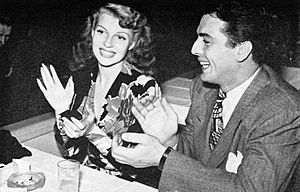
Hayworth's two younger brothers, Eduardo Cansino Jr. and Vernon Cansino, both served in World War II. Vernon left the United States Army in 1946 with several medals, including the Purple Heart, and later married Susan Vail, a dancer. Eduardo Jr. followed Hayworth into acting; he was also under contract with Columbia Pictures. In 1950, he made his screen debut in The Great Adventures of Captain Kidd.
Hayworth was married and divorced five times. She had two grandsons: Marc McKerrow by Rebecca Welles, who married and had children, and Andrew Ali Aga Khan Embiricos by Yasmin Aga Khan, who died unmarried.
Relationship with Glenn Ford
Hayworth also had a long-term on-and-off 40-year affair with Glenn Ford, which they started during the filming of Gilda in 1945. Their relationship is documented in the 2011 biography Glenn Ford: A Life by Ford's son, Peter Ford. Ford later moved next door to her in Beverly Hills in 1960, and they continued their relationship for many years until the early 1980s.
Spouses
Edward Charles Judson
In 1937, when Hayworth was 18, she married Edward C. Judson, an oilman turned promoter who was more than twice her age. They married in Las Vegas. He had played a major role in launching her acting career. A shrewd businessman, he was domineering and became her manager for months before he proposed. "He helped me with my career", Hayworth conceded after they divorced, "and helped himself to my money." She alleged that Judson compelled her to transfer a considerable amount of her property to him, and she promised to pay him $12,000 under threats that he would do her "great bodily harm".
She filed for divorce from him on February 24, 1942.
Orson Welles
Hayworth married Orson Welles on September 7, 1943, during the run of The Mercury Wonder Show. None of her colleagues knew about the planned wedding (before a judge) until she announced it the day before. For the civil ceremony, she wore a beige suit, a ruffled white blouse, and a veil. A few hours after they got married, they returned to work at the studio. They had a daughter, Rebecca, who was born on December 17, 1944, and died at the age of 59 on October 17, 2004.
On November 10, 1947, she was granted a divorce that became final the following year.
Prince Aly Khan
In 1948, Hayworth left her film career to marry Prince Aly Khan, a son of Sultan Mahommed Shah, Aga Khan III, the leader of the Ismaili community of Shia Islam. They were married on May 27, 1949. Her bridal trousseau was designed by Jacques Fath.
Aly Khan and his family were heavily involved in horse racing, owning and racing horses. Hayworth had no interest in the sport, but became a member of the Del Mar Thoroughbred Club anyway. Her filly, Double Rose, won several races in France and finished second in the 1949 Prix de l'Arc de Triomphe.
In 1951, while still married to Hayworth, Khan was spotted dancing with the actress Joan Fontaine in the nightclub where he and Hayworth had met. Hayworth threatened to divorce him in Reno, Nevada. In early May, Hayworth moved to Nevada to establish legal residence to qualify for a divorce. She stayed at Lake Tahoe with their daughter, saying there was a threat the child would be kidnapped. Hayworth filed for divorce from Khan on September 2, 1951.
Hayworth once said she might convert to Islam, but did not. During the custody fight over their daughter, Princess Yasmin Aga Khan, born December 28, 1949, the prince said he wanted her to be raised as a Muslim; Hayworth wanted the child to be raised as a Christian.
In January 1953, Hayworth was granted a divorce from Aly Khan on the grounds of extreme mental cruelty. Her daughter Yasmin, only three years old, played about the court while the case was being heard, finally climbing on to the judge's lap.
Dick Haymes
When Hayworth and Dick Haymes first met, he was still married and his singing career was waning. When she showed up at the clubs, he got a larger audience. Haymes was desperate for money because two of his former wives were taking legal action against him for unpaid child support. His financial problems were so bad, he could not return to California without being arrested. On July 7, 1954, his ex-wife Nora Eddington got a bench warrant for his arrest, because he owed her $3,800 in alimony. Less than a week earlier, his other ex-wife, Joanne Dru, also got a bench warrant because she said he owed $4,800 in support payments for their three children. Hayworth ended up paying most of Haymes's debts.
Haymes was born in Argentina and did not have solid proof of American citizenship. Not long after he met Hayworth, U.S. officials initiated proceedings to have him deported to Argentina for being an illegal alien. He hoped Hayworth could influence the government and keep him in the United States. When she assumed responsibility for his citizenship, a bond was formed that led to marriage. The two were married on September 24, 1953, at the Sands Hotel, Las Vegas, and their wedding procession went through the casino.
After a tumultuous two years together, Hayworth packed her bags, walked out, and never returned.
James Hill
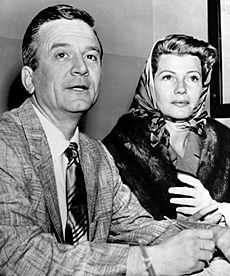
Hayworth began a relationship with film producer James Hill, whom she went on to marry on February 2, 1958. He put her in one of her last major films, Separate Tables. This film was popular and highly praised, although The Harvard Lampoon named her the worst actress of 1958 for her performance. On September 1, 1961, Hayworth filed for divorce. Hill later wrote Rita Hayworth: A Memoir, in which he suggested that their marriage collapsed because he wanted Hayworth to continue making movies, while she wanted them both to retire from Hollywood.
Health
In 1972, the 54-year-old Hayworth wanted to retire from acting, but she needed money. At the suggestion of Robert Mitchum, she agreed to film The Wrath of God. The experience exposed her poor health and her worsening mental state. Because she could not remember her lines, her scenes were shot one line at a time. In November, she agreed to complete one more movie, the British film Tales That Witness Madness, but because of her worsening health, she left the set and returned to the United States. She never returned to acting.
In March 1974, both of her brothers died within a week of each other, which caused her great sadness. In January 1976, at London's Heathrow Airport, Hayworth was removed from a TWA flight after having an angry outburst while traveling with her agent. The event attracted much negative publicity; a disturbing photograph was published in newspapers the next day. Hayworth later was diagnosed with Alzheimer's disease.
In July 1981, Hayworth's health had deteriorated to the point that a judge in Los Angeles Superior Court ruled that she should be placed under the care of her daughter, Princess Yasmin Aga Khan of New York City. Hayworth lived in an apartment at The San Remo on Central Park West adjoining that of her daughter, who arranged for her mother's care during her final years. When asked how her mother was doing, Yasmin replied, "She's still beautiful. But it's a shell."
In 1983, Rebecca Welles arranged to see her mother for the first time in seven years. Speaking to his lifelong friend Roger Hill, Orson Welles expressed his concern about the visit's effect on his daughter. "Rita barely knows me now", Welles said. He recalled seeing Hayworth three years before at an event which the Reagans held for Frank Sinatra. "When it was over, I came over to her table, and I saw that she was very beautiful, very reposed looking, and didn't know me at first. After about four minutes of speaking, I could see that she realized who I was, and she began to cry quietly."
In an interview which he gave the evening before his death in 1985, Welles called Hayworth "one of the dearest and sweetest women that ever lived".
Political views
Hayworth was a lifelong Democrat who was an active member of the Hollywood Democratic Committee and was active in the campaign of Franklin Delano Roosevelt during the 1944 presidential election.
Religion
Hayworth was a Catholic whose marriage to Prince Aly Khan was deemed "illicit" by Pope Pius XII.
Death
Rita Hayworth lapsed into a semicoma in February 1987. She died at age 68, from complications associated with Alzheimer's disease, on May 14, 1987 at her home in Manhattan.
A funeral service was held on May 18, 1987, at the Church of the Good Shepherd. Pallbearers included actors Ricardo Montalbán, Glenn Ford, Cesar Romero, Anthony Franciosa, choreographer Hermes Pan, and a family friend, Phillip Luchenbill. She was interred at Holy Cross Cemetery, Culver City. Her headstone includes Yasmin's sentiment: "To yesterday's companionship and tomorrow's reunion."
Filmography
| Year | Title | Role | Notes | Ref. |
|---|---|---|---|---|
| 1926 | La Fiesta | Short; credited as Rita Cansino | ||
| 1934 | Cruz Diablo | Extra | Uncredited | |
| 1935 | In Caliente | Credited as Rita Cansino | ||
| Under the Pampas Moon | Carmen | |||
| Charlie Chan in Egypt | Nayda | |||
| Dante's Inferno | Dancer | |||
| Piernas de seda | Ballerina | Uncredited | ||
| Hi, Gaucho! | Dolores | |||
| Paddy O'Day | Tamara Petrovitch | Credited as Rita Cansino | ||
| 1936 | Professional Soldier | Gypsy Dancer | ||
| Human Cargo | Carmen Zoro | |||
| Dancing Pirate | Specialty Dancer | Uncredited | ||
| Meet Nero Wolfe | Maria Maringola | Credited as Rita Cansino | ||
| Rebellion | Paula Castillo | Alternative title: Lady from Frisco Credited as Rita Cansino |
||
| 1937 | Old Louisiana | Angela Gonzales | Alternative title: Louisiana Gal Credited as Rita Cansino |
|
| Hit the Saddle | Rita | Credited as Rita Cansino | ||
| Trouble in Texas | Carmen Serano | |||
| Criminals of the Air | Rita Owens | |||
| Girls Can Play | Sue Collins | |||
| The Game That Kills | Betty Holland | |||
| Life Begins with Love | Dinner Guest's Girl Friend | Uncredited | ||
| Paid to Dance | Betty Morgan | Alternative title: Hard to Hold | ||
| The Shadow | Mary Gillespie | |||
| 1938 | Who Killed Gail Preston? | Gail Preston | ||
| Special Inspector | Patricia Lane | Alternative title: Across the Border | ||
| There's Always a Woman | Mary—Ketterling's Secretary | Uncredited | ||
| Convicted | Jerry Wheeler | |||
| Juvenile Court | Marcia Adams | |||
| The Renegade Ranger | Judith Alvarez | |||
| 1939 | Homicide Bureau | J.G. Bliss | ||
| The Lone Wolf Spy Hunt | Karen | |||
| Only Angels Have Wings | Judy MacPherson | |||
| 1940 | Music in My Heart | Patricia O'Malley | ||
| Blondie on a Budget | Joan Forrester | |||
| Susan and God | Leonora Stubbs | |||
| The Lady in Question | Natalie Roguin | |||
| 1940 | Angels Over Broadway | Nina Barona | ||
| 1941 | The Strawberry Blonde | Virginia Brush | ||
| Affectionately Yours | Irene Malcolm | |||
| Blood and Sand | Doña Sol | |||
| You'll Never Get Rich | Sheila Winthrop | |||
| 1942 | My Gal Sal | Sally Elliott | ||
| Tales of Manhattan | Ethel Halloway | |||
| You Were Never Lovelier | Maria Acuña | |||
| 1944 | Cover Girl | Rusty Parker/Maribelle Hicks | ||
| 1945 | Tonight and Every Night | Rosalind Bruce | ||
| 1946 | Gilda | Gilda Mundson Farrell | ||
| 1947 | Down to Earth | Terpsichore/Kitty Pendleton | ||
| The Lady from Shanghai | Elsa Bannister | |||
| 1948 | The Loves of Carmen | Carmen | Also producer (uncredited) | |
| 1952 | Affair in Trinidad | Chris Emery | Also producer (uncredited) | |
| 1953 | Salome | Princess Salome | Alternative title: Salome: The Dance of the Seven Veils Also producer (uncredited) |
|
| Miss Sadie Thompson | Sadie Thompson | |||
| 1957 | Fire Down Below | Irena | ||
| Pal Joey | Vera Prentice-Simpson | |||
| 1958 | Separate Tables | Ann Shankland | ||
| 1959 | They Came to Cordura | Adelaide Geary | ||
| The Story on Page One | Josephine Brown/Jo Morris | |||
| 1961 | The Happy Thieves | Eve Lewis | Also executive producer | |
| 1964 | Circus World | Lili Alfredo | ||
| 1965 | The Money Trap | Rosalie Kenny | ||
| 1966 | The Poppy Is Also a Flower | Monique Marko | Television film | |
| 1967 | The Rover | Aunt Caterina | Alternative title: L'avventuriero | |
| 1970 | Road to Salina | Mara | Alternative title: La route de Salina | |
| The Naked Zoo | Mrs. Golden | |||
| 1971 | The Carol Burnett Show | Herself | TV series (Episode #4.20) | |
| Rowan & Martin's Laugh-In | TV series (Episode #5.3) | |||
| 1972 | The Wrath of God | Señora De La Plata |
Accolades
Hayworth received a Golden Globe nomination for Best Actress – Motion Picture Drama for her performance in Circus World (1964).
In 1978, at the Shoreham Hotel in Washington, D. C., Hayworth was presented with the inaugural National Screen Heritage Award of the National Film Society, a group that published American Classic Screen magazine (1976–1984).
In 1999, Hayworth was acknowledged as one of the top-25 greatest female stars of Classic Hollywood cinema in the American Film Institute's survey, AFI's 100 Years...100 Stars.
Legacy
The public disclosure and discussion of Hayworth's illness drew international attention to Alzheimer's disease, which was little known at the time, and it helped to greatly increase federal funding for Alzheimer's research.
The Rita Hayworth Gala, a benefit for the Alzheimer's Association, is held annually in Chicago and New York City. The program was founded in 1985 by Princess Yasmin Aga Khan, in honor of her mother. She is the hostess for the events and a major sponsor of Alzheimer's disease charities and awareness programs. As of August 2017[update], a total of more than $72 million had been raised through events in Chicago, New York, and Palm Beach, Florida.
On October 17, 2016, a press release from the Springer Associates Public Relations Agency announced that Rita Hayworth's former manager and friend, Budd Burton Moss, initiated a campaign to solicit the United States Postal Service to issue a commemorative stamp featuring Hayworth. Springer Associates also announced that the Academy of Motion Picture Arts and Sciences would be lobbied in hopes of having an honorary Academy Award issued in memory of Hayworth. The press release added that Hayworth's daughter, Princess Yasmin Aga Khan, the Alzheimer's Association of Greater Los Angeles, and numerous prominent personalities of stage and screen were supporting the Moss campaign. The press release stated the target date for fulfillment of the stamp and Academy Award to be on October 17, 2018, on what will be the centennial of Hayworth's birth.
See also
 In Spanish: Rita Hayworth para niños
In Spanish: Rita Hayworth para niños


